WEP GWR Glass Wagon - Coral 'A' Diagram D2
© Raymond Walley 2012 - All rights reserved. Transferred to Wiki by Tommy Day
Originally manufactured by: WEP Models, 30 Milcote Road, Bearwood, SMETHWICK, B76 5BN
Now available from Walsall Model Industries
| Failed to open database: gaugegu1_gog2 | ret is false |
An unusual, and rare, prototype.
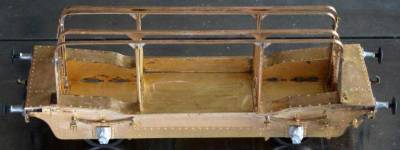
What's in the Box?
The kit comes as usual in a flat pack, a sheet of etch, a bag of castings (of which
the buffers were instantly scrapped and replaced with an integrally sprung set),
some wire and Bill's normal set of excellent instructions with a scale drawing.
I read through the suggested build sequence to see if there were any surprises;
there were none so I began by punching out a good many rivets heads and then
assembled as many components as possible while the parts were 'in the flat'.
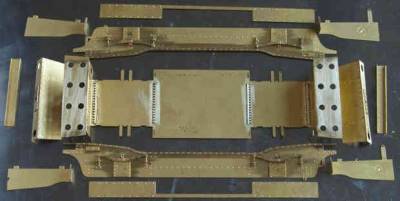 Here are the main parts for the body. The sides have the springs, overlays and
label pockets fixed. The springs are a laminated etch but somewhat different to
those for the opens (for instance) and had to be assembled in reverse order
compared with my normal method. They require some care but produce a fine
representation.
Here are the main parts for the body. The sides have the springs, overlays and
label pockets fixed. The springs are a laminated etch but somewhat different to
those for the opens (for instance) and had to be assembled in reverse order
compared with my normal method. They require some care but produce a fine
representation.
Here are most of the parts for the brakes; the blocks and hangers must be fitted to the body before assembly
has progressed very far. They fit to inside side sheets for the wheel covers;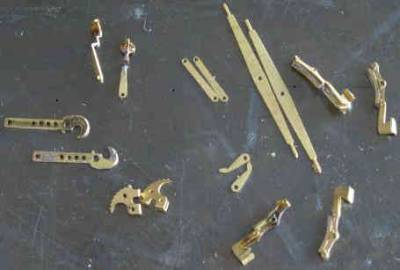
I fixed them to the parts (one in each corner in the first picture) before fitting those parts to the body.
The frames that hold the crates upright were made up largely as suggested except that I decided to make
the locking bars movable and the non-fixed frame removable too. 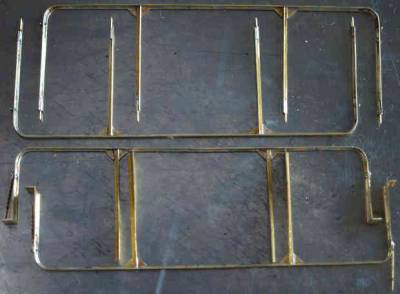 The frames need care to get the angle iron accurately soldered. This is an edge
solder at right angles to the flat side.
The frames need care to get the angle iron accurately soldered. This is an edge
solder at right angles to the flat side. The rare earth magnets came in very handy for this job and made it relatively easy. I used cut down steel pins for the
lock bar pivot and the catch on the opposite, movable, frame.
The rare earth magnets came in very handy for this job and made it relatively easy. I used cut down steel pins for the
lock bar pivot and the catch on the opposite, movable, frame.
The support fittings to hold the brake gear in place need to be soldered in place
before the body is assembled. Here the body is part built shewing the brake
blocks and brake pivot supports fixed in place.  A side view, it captures the original very well.
A side view, it captures the original very well.
And here is the view from the top that clearly shows the brake hangers suspended from the
wheel arch ends. 
The brake gear is fiddly, Part of the linkage has
to go through a hole in the vehicle end, but it is
doable. I decided not to put in the full linkage
across the wheel axle to the brake stretcher bar
or the wheel units could not have been fitted
later and anyway, they are invisible once the
wheels are fitted. Here is a set fitted and set
waiting to be assembled. 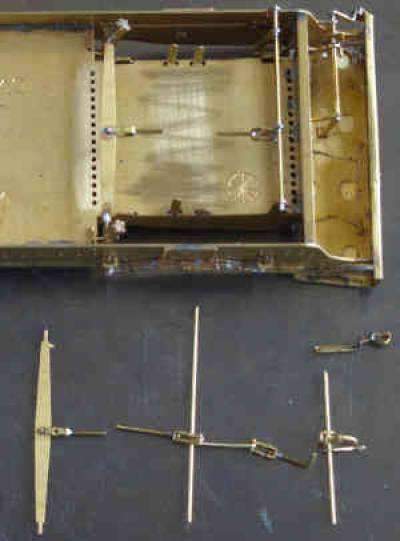
The wheel units are not of the type
usually found in WEP kits; there is not
room for them so a slightly different
method is used. The rocking axle
pivots about the central pillar with oval
holes in the supports. I do not like single thickness bearings and so laminated
some brass washers in place and opened the holes in the compensated unit to
match the ovals in the original.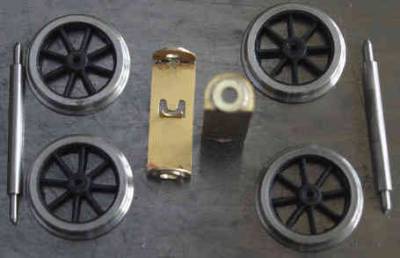
When assembled as a unit, they still need a
packing washer each side to prevent excessive side play and consequent
'hunting' on the track.
This is not an easy kit to build but, given care, that mythical creature the 'average' modeller could do it. Many of the parts are delicate with not a great deal of area for soldering so some skill is required. I think, without the RSU and rare earth magnets, it would have been more difficult but far from impossible.
The decking over the wheels arches comes as a single piece for each side with a witness mark at the centre. The intention being to begin in the centre and work outwards. I found the parts a fraction overlong. I cut them half in the centre and fitted them as four individual pieces; it just seemed easier to me that way. Care is also needed when soldering in the centre uprights to avoid unsoldering the brake hangers and yes, I managed to do that once. However, the RSU generally makes it much easier to solder up parts close together without recourse to step soldering, it just takes a little practice and use of judicious heat sinks AKA aluminium hairgrips.
Fitting the buffers proved 'interesting' as there is very little space in which to
operate while starting the thread. A cocktail stick with a tiny piece of Bluetack
did the trick since I was able to hold the nut in place to get the thread started and
then hold it steady with a scalpel blade while running it up the thread.
Here is another picture of the completed vehicle.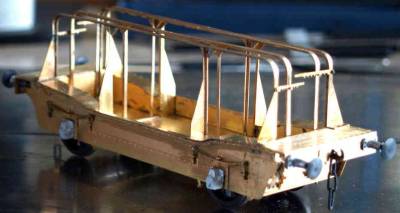 The inner frames are not fixed, simply inserted in the relevant holes and the locking bar thrown across.
The inner frames are not fixed, simply inserted in the relevant holes and the locking bar thrown across.
I did it this way for two reasons; one, because I wanted to see if it could be done and two, to enable my client to decide if he wants them to hold a load in place, when they can be glued in. They are off soon to their final home to be painted.
Bill Parker’s response. Hi Raymond, have just read your review and as usual, I find your comments fair and constructive for any other would be builders of this kit. It is unusual and presented quite a few design headaches but as you have shown, with care and patience it builds up into a fair representation of the prototype. Regards Bill Parker: WEP Models.





